2008 MERCEDES-BENZ GLK SUV warning light
[x] Cancel search: warning lightPage 204 of 261
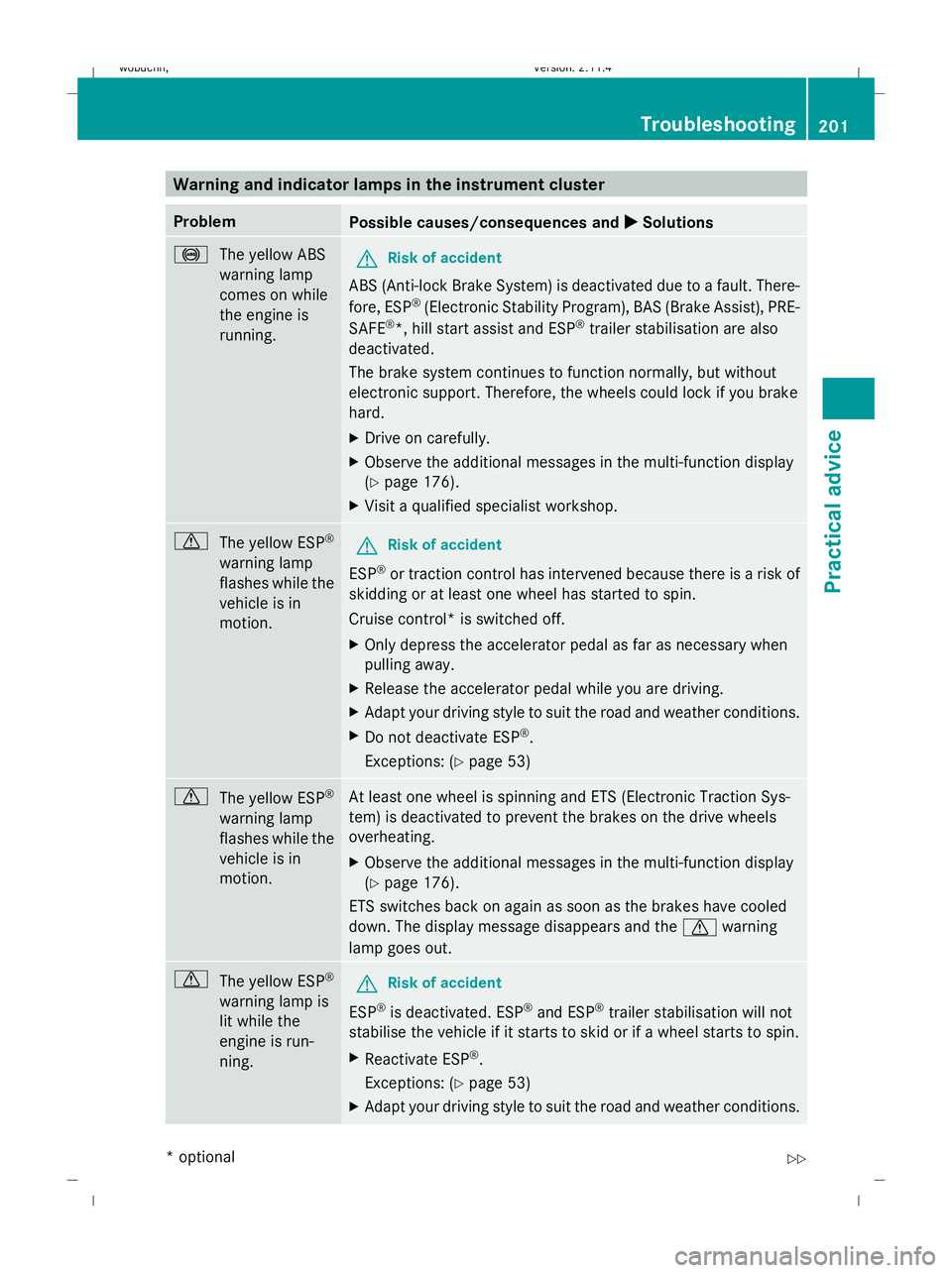
Warning and indicator lamps in the instrument cluster
Problem
Possible causes/consequences and
X
X Solutions !
The yellow ABS
warning lamp
comes on while
the engine is
running. G
Risk of accident
ABS (Anti-lock Brake System) is deactivated due to a fault. There-
fore, ESP ®
(Electronic Stability Program), BAS (Brake Assist), PRE-
SAFE ®
*, hill start assist and ESP ®
trailer stabilisation are also
deactivated.
The brake system continues to function normally, but without
electronic support. Therefore, the wheels could lock if you brake
hard.
X Drive on carefully.
X Observe the additional messages in the multi-function display
(Y page 176).
X Visit a qualified specialist workshop. d
The yellow ESP ®
warning lamp
flashes while the
vehicle is in
motion. G
Risk of accident
ESP ®
or traction control has intervened because there is a risk of
skidding or at least one wheel has started to spin.
Cruise control* is switched off.
X Only depress the accelerator pedal as far as necessary when
pulling away.
X Release the accelerator pedal while you are driving.
X Adapt your driving style to suit the road and weather conditions.
X Do not deactivate ESP ®
.
Exceptions: (Y page 53) d
The yellow ESP ®
warning lamp
flashes while the
vehicle is in
motion. At least one wheel is spinning and ETS (Electronic Traction Sys-
tem) is deactivated to prevent the brakes on the drive wheels
overheating.
X
Observe the additional messages in the multi-function display
(Y page 176).
ETS switches back on again as soon as the brakes have cooled
down. The display message disappears and the dwarning
lamp goes out. d
The yellow ESP ®
warning lamp is
lit while the
engine is run-
ning. G
Risk of accident
ESP ®
is deactivated. ESP ®
and ESP ®
trailer stabilisation will not
stabilise the vehicle if it starts to skid or if a wheel starts to spin.
X Reactivate ESP ®
.
Exceptions: (Y page 53)
X Adapt your driving style to suit the road and weather conditions. Troubleshooting
201Practical advice
* optional
X204_AKB; 1; 5, en-GB
wobuchh,
Version: 2.11.4 2008-10-15T13:20:56+02:00 - Seite 201 ZDateiname: 6515_0671_02_buchblock.pdf; preflight
Page 205 of 261
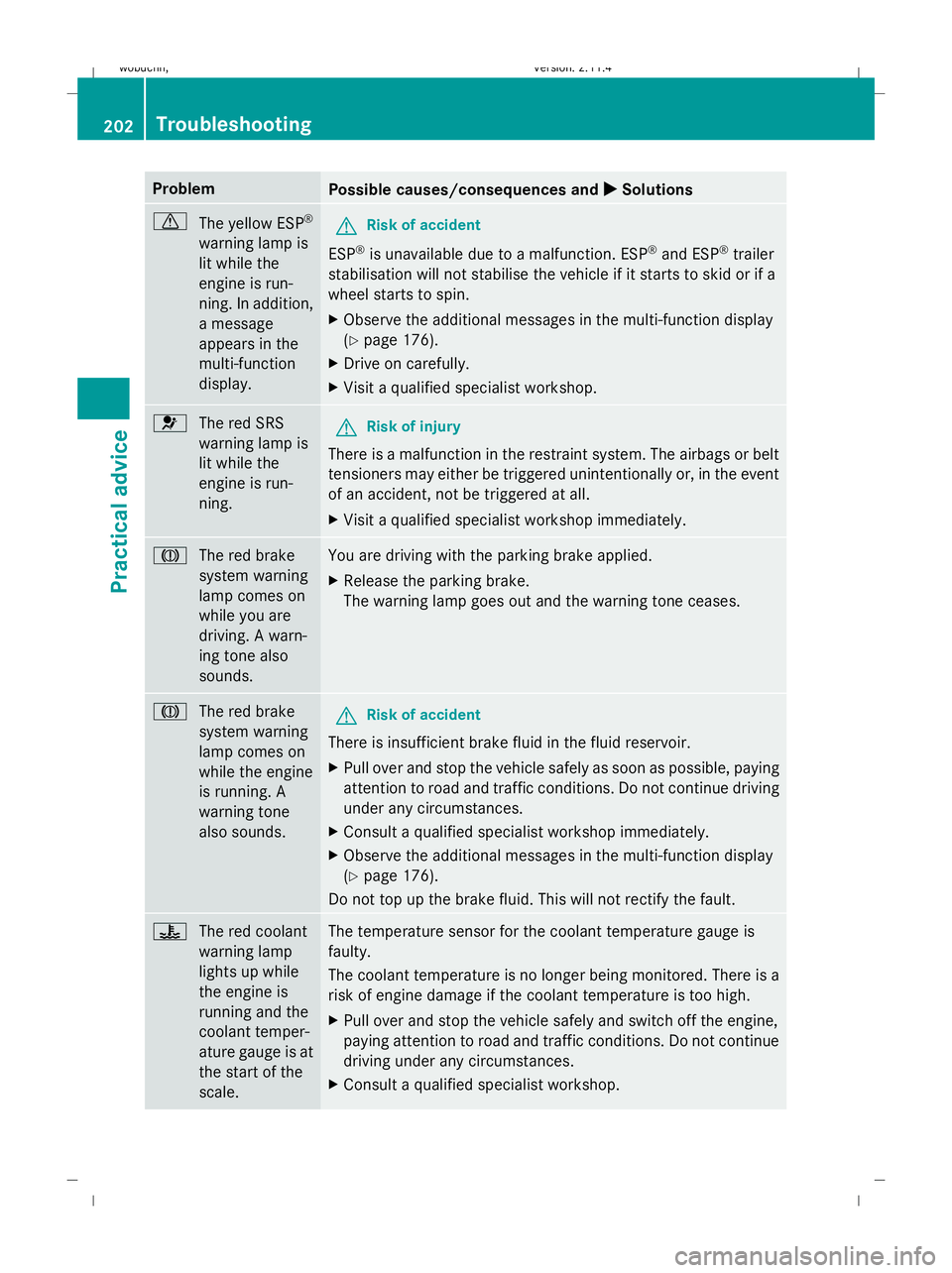
Problem
Possible causes/consequences and
X XSolutions d
The yellow ESP ®
warning lamp is
lit while the
engine is run-
ning. In addition,
a message
appears in the
multi-function
display. G
Risk of accident
ESP ®
is unavailable due to a malfunction. ESP ®
and ESP ®
trailer
stabilisation will not stabilise the vehicle if it starts to skid or if a
wheel starts to spin.
X Observe the additional messages in the multi-function display
(Y page 176).
X Drive on carefully.
X Visit a qualified specialist workshop. 6
The red SRS
warning lamp is
lit while the
engine is run-
ning. G
Risk of injury
There is a malfunction in the restraint system. The airbags or belt
tensioners may either be triggered unintentionally or, in the event
of an accident, not be triggered at all.
X Visit a qualified specialist workshop immediately. J
The red brake
system warning
lamp comes on
while you are
driving. A warn-
ing tone also
sounds. You are driving with the parking brake applied.
X
Release the parking brake.
The warning lamp goes out and the warning tone ceases. J
The red brake
system warning
lamp comes on
while the engine
is running. A
warning tone
also sounds. G
Risk of accident
There is insufficient brake fluid in the fluid reservoir.
X Pull over and stop the vehicle safely as soon as possible, paying
attention to road and traffic conditions. Do not continue driving
under any circumstances.
X Consult a qualified specialist workshop immediately.
X Observe the additional messages in the multi-function display
(Y page 176).
Do not top up the brake fluid. This will not rectify the fault. ?
The red coolant
warning lamp
lights up while
the engine is
running and the
coolant temper-
ature gauge is at
the start of the
scale. The temperature sensor for the coolant temperature gauge is
faulty.
The coolant temperature is no longer being monitored. There is a
risk of engine damage if the coolant temperature is too high.
X
Pull over and stop the vehicle safely and switch off the engine,
paying attention to road and traffic conditions. Do not continue
driving under any circumstances.
X Consult a qualified specialist workshop. 202 TroubleshootingPractical advice
X204_AKB; 1; 5, en-GB
wobuchh,
Version: 2.11.4 2008-10-15T13:20:56+02:00 - Seite 202Dateiname: 6515_0671_02_buchblock.pdf; preflight
Page 206 of 261
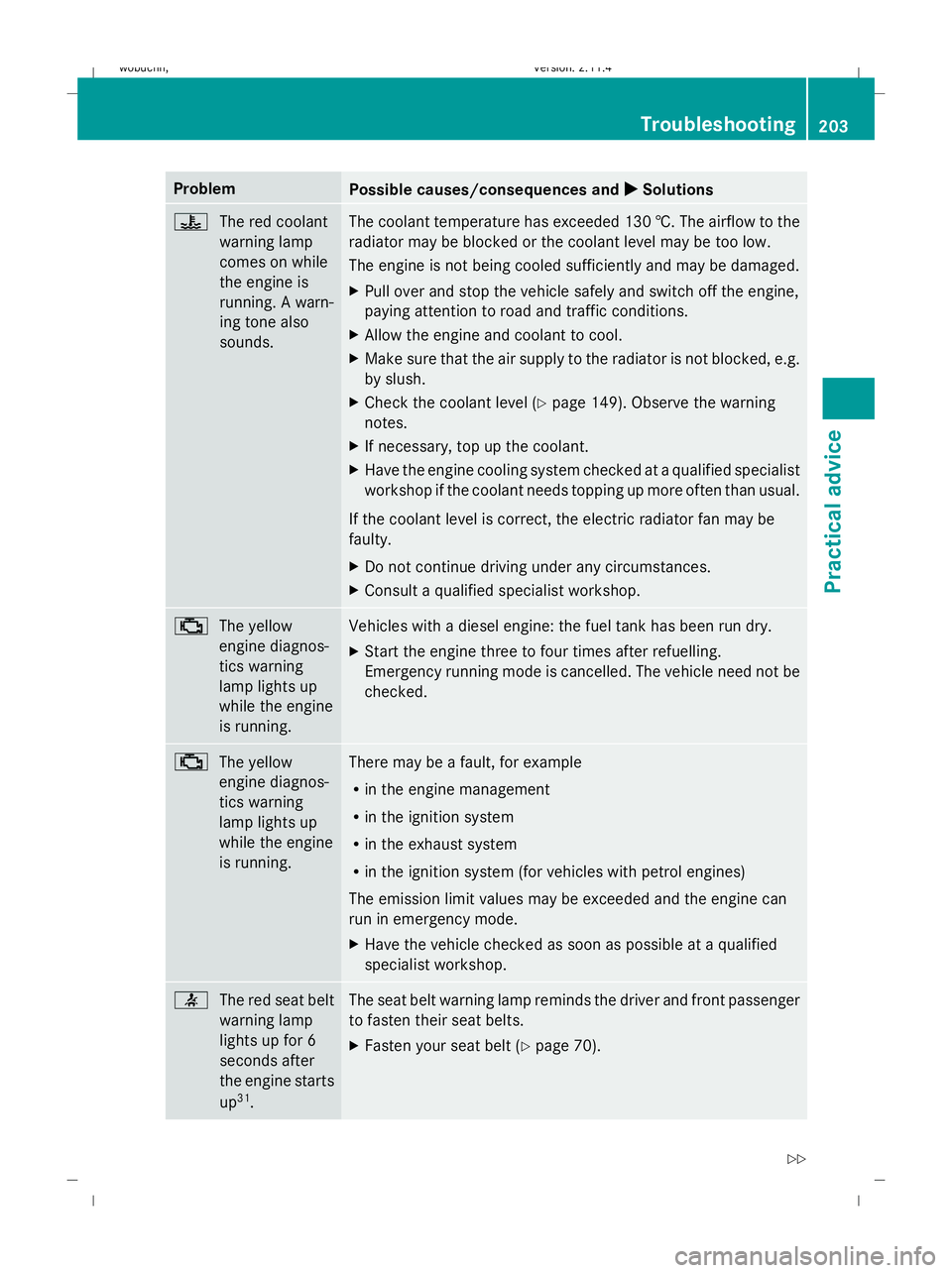
Problem
Possible causes/consequences and
X
X Solutions ?
The red coolant
warning lamp
comes on while
the engine is
running. A warn-
ing tone also
sounds. The coolant temperature has exceeded 130 †. The airflow to the
radiator may be blocked or the coolant level may be too low.
The engine is not being cooled sufficiently and may be damaged.
X
Pull over and stop the vehicle safely and switch off the engine,
paying attention to road and traffic conditions.
X Allow the engine and coolant to cool.
X Make sure that the air supply to the radiator is not blocked, e.g.
by slush.
X Check the coolant level (Y page 149). Observe the warning
notes.
X If necessary, top up the coolant.
X Have the engine cooling system checked at a qualified specialist
workshop if the coolant needs topping up more often than usual.
If the coolant level is correct, the electric radiator fan may be
faulty.
X Do not continue driving under any circumstances.
X Consult a qualified specialist workshop. ;
The yellow
engine diagnos-
tics warning
lamp lights up
while the engine
is running. Vehicles with a diesel engine: the fuel tank has been run dry.
X
Start the engine three to four times after refuelling.
Emergency running mode is cancelled. The vehicle need not be
checked. ;
The yellow
engine diagnos-
tics warning
lamp lights up
while the engine
is running. There may be a fault, for example
R
in the engine management
R in the ignition system
R in the exhaust system
R in the ignition system (for vehicles with petrol engines)
The emission limit values may be exceeded and the engine can
run in emergency mode.
X Have the vehicle checked as soon as possible at a qualified
specialist workshop. 7
The red seat belt
warning lamp
lights up for 6
seconds after
the engine starts
up31
. The seat belt warning lamp reminds the driver and front passenger
to fasten their seat belts.
X Fasten your seat belt (Y page 70). Troubleshooting
203Practical advice
X204_AKB; 1; 5, en-GB
wobuchh, Version: 2.11.4 2008-10-15T13:20:56+02:00 - Seite 203 ZDateiname: 6515_0671_02_buchblock.pdf; preflight
Page 207 of 261
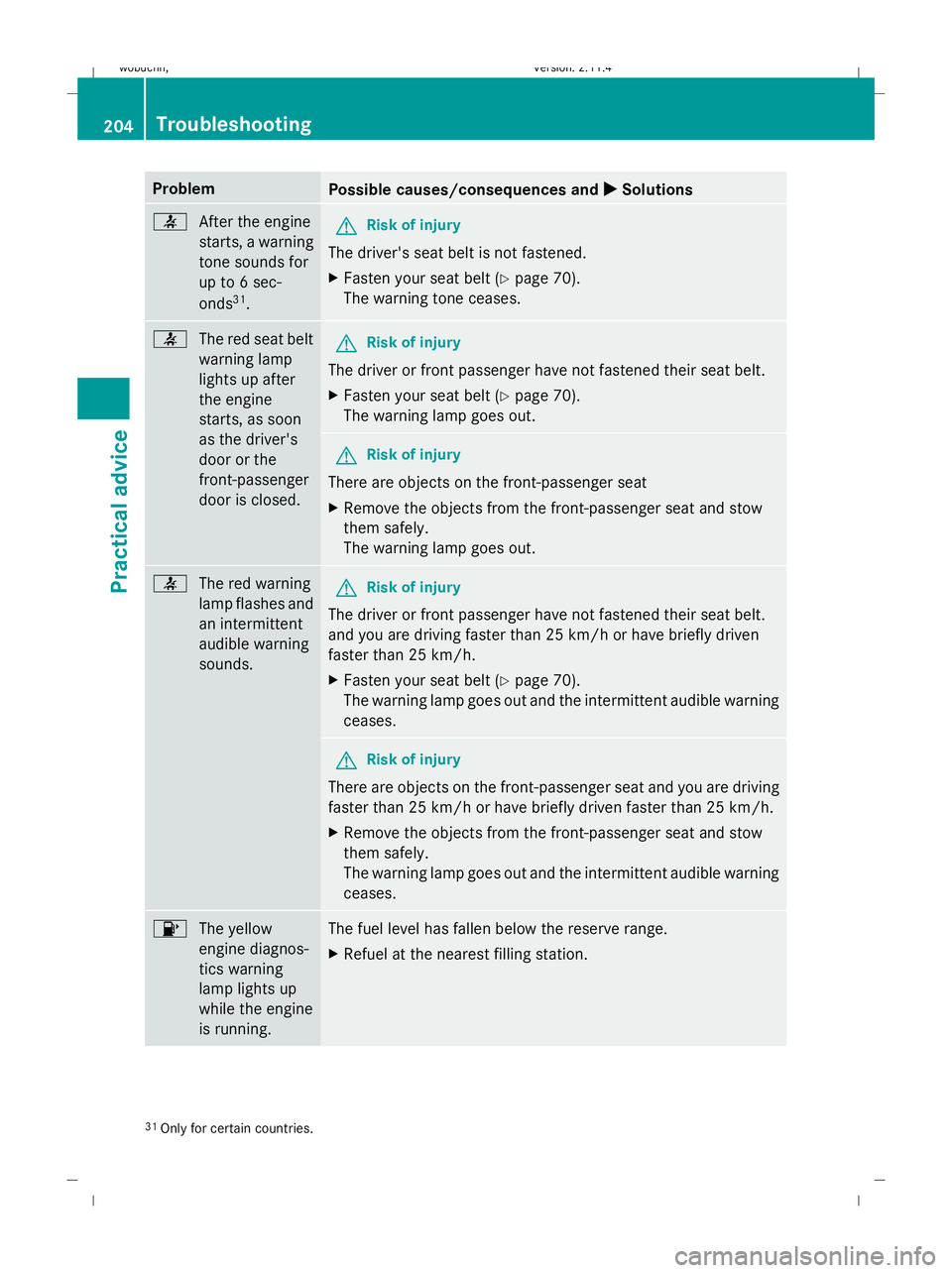
Problem
Possible causes/consequences and
X XSolutions 7
After the engine
starts, a warning
tone sounds for
up to 6 sec-
onds31
. G
Risk of injury
The driver's seat belt is not fastened.
X Fasten your seat belt (Y page 70).
The warning tone ceases. 7
The red seat belt
warning lamp
lights up after
the engine
starts, as soon
as the driver's
door or the
front-passenger
door is closed. G
Risk of injury
The driver or front passenger have not fastened their seat belt.
X Fasten your seat belt (Y page 70).
The warning lamp goes out. G
Risk of injury
There are objects on the front-passenger seat
X Remove the objects from the front-passenger seat and stow
them safely.
The warning lamp goes out. 7
The red warning
lamp flashes and
an intermittent
audible warning
sounds. G
Risk of injury
The driver or front passenger have not fastened their seat belt.
and you are driving faster than 25 km/h or have briefly driven
faster than 25 km/h.
X Fasten your seat belt (Y page 70).
The warning lamp goes out and the intermittent audible warning
ceases. G
Risk of injury
There are objects on the front-passenger seat and you are driving
faster than 25 km/h or have briefly driven faster than 25 km/h.
X Remove the objects from the front-passenger seat and stow
them safely.
The warning lamp goes out and the intermittent audible warning
ceases. 8
The yellow
engine diagnos-
tics warning
lamp lights up
while the engine
is running. The fuel level has fallen below the reserve range.
X
Refuel at the nearest filling station. 31
Only for certain countries. 204 TroubleshootingPractical advice
X204_AKB; 1; 5, en-GB
wobuchh,
Version: 2.11.4 2008-10-15T13:20:56+02:00 - Seite 204Dateiname: 6515_0671_02_buchblock.pdf; preflight
Page 208 of 261
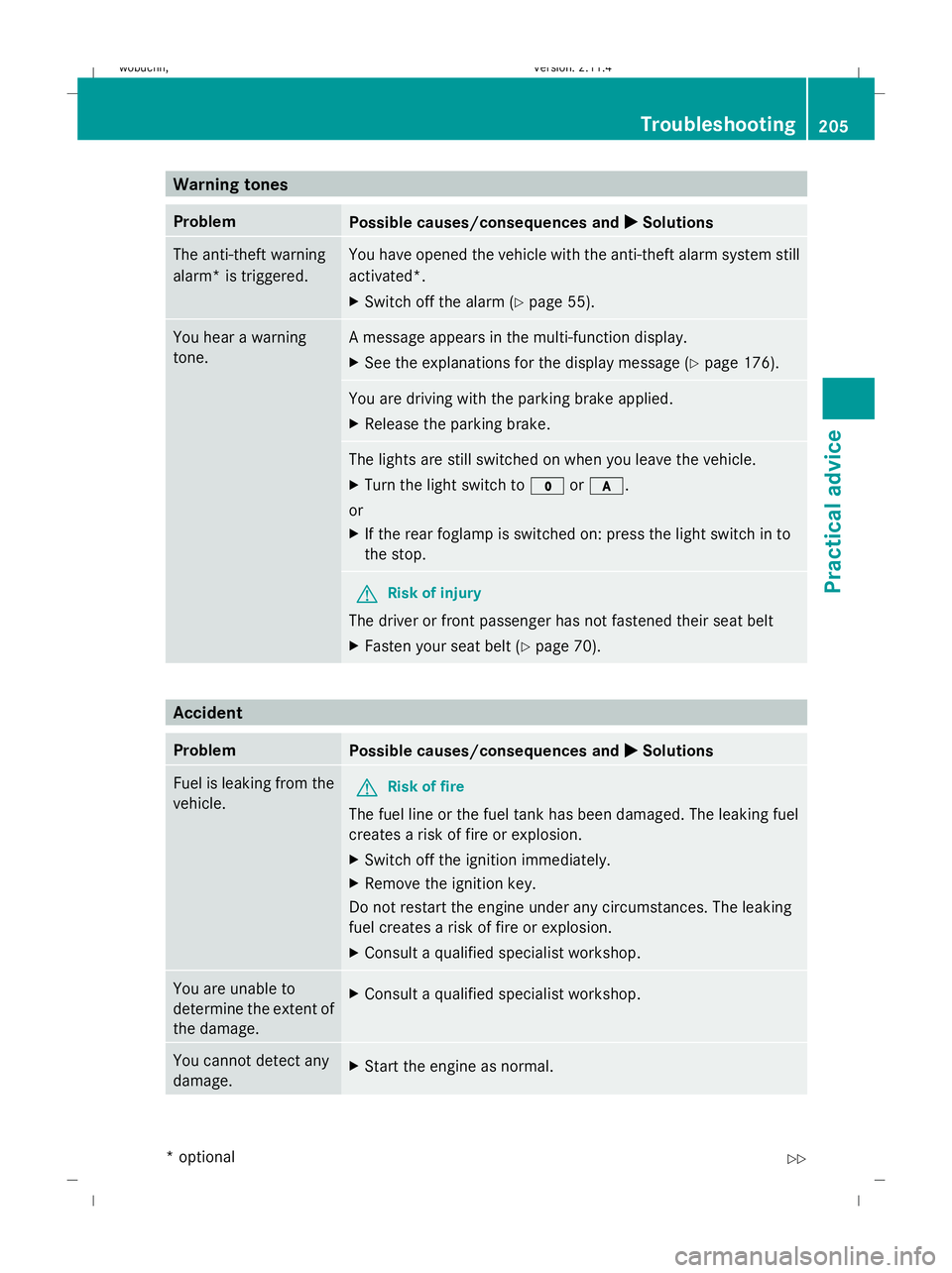
Warning tones
Problem
Possible causes/consequences and
X
X Solutions The anti-theft warning
alarm* is triggered. You have opened the vehicle with the anti-theft alarm system still
activated*.
X Switch off the alarm (Y page 55). You hear a warning
tone. A message appears in the multi-function display.
X
See the explanations for the display message (Y page 176). You are driving with the parking brake applied.
X
Release the parking brake. The lights are still switched on when you leave the vehicle.
X
Turn the light switch to $orc.
or
X If the rear foglamp is switched on: press the light switch in to
the stop. G
Risk of injury
The driver or front passenger has not fastened their seat belt
X Fasten your seat belt (Y page 70). Accident
Problem
Possible causes/consequences and
X
X Solutions Fuel is leaking from the
vehicle.
G
Risk of fire
The fuel line or the fuel tank has been damaged. The leaking fuel
creates a risk of fire or explosion.
X Switch off the ignition immediately.
X Remove the ignition key.
Do not restart the engine under any circumstances. The leaking
fuel creates a risk of fire or explosion.
X Consult a qualified specialist workshop. You are unable to
determine the extent of
the damage.
X
Consult a qualified specialist workshop. You cannot detect any
damage.
X
Start the engine as normal. Troubleshooting
205Practical advice
* optional
X204_AKB; 1; 5, en-GB
wobuchh,
Version: 2.11.4 2008-10-15T13:20:56+02:00 - Seite 205 ZDateiname: 6515_0671_02_buchblock.pdf; preflight
Page 210 of 261
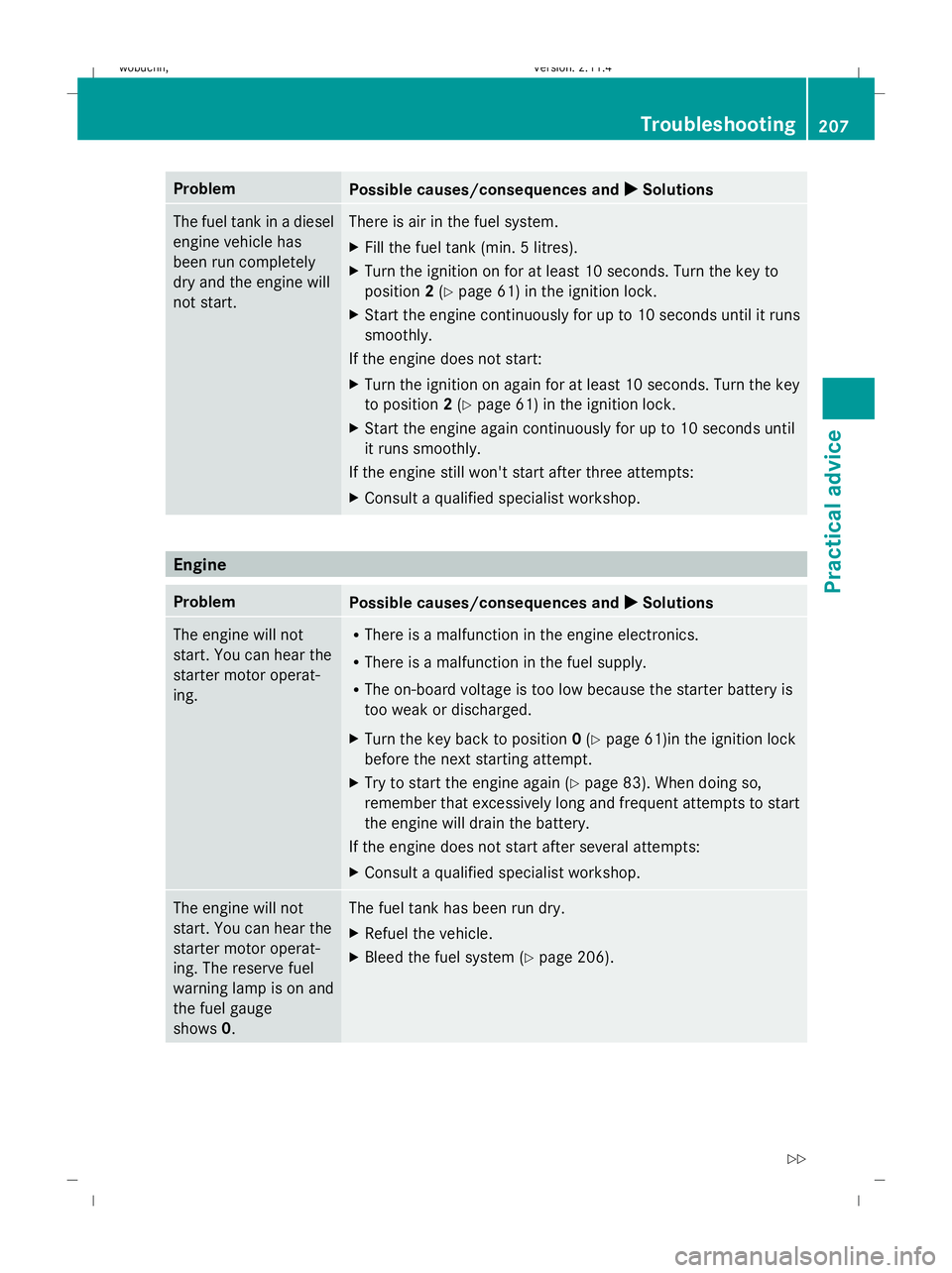
Problem
Possible causes/consequences and
X
X Solutions The fuel tank in a diesel
engine vehicle has
been run completely
dry and the engine will
not start. There is air in the fuel system.
X Fill the fuel tank (min. 5 litres).
X Turn the ignition on for at least 10 seconds. Turn the key to
position 2(Y page 61) in the ignition lock.
X Start the engine continuously for up to 10 seconds until it runs
smoothly.
If the engine does not start:
X Turn the ignition on again for at least 10 seconds. Turn the key
to position 2(Y page 61) in the ignition lock.
X Start the engine again continuously for up to 10 seconds until
it runs smoothly.
If the engine still won't start after three attempts:
X Consult a qualified specialist workshop. Engine
Problem
Possible causes/consequences and
X
X Solutions The engine will not
start. You can hear the
starter motor operat-
ing. R
There is a malfunction in the engine electronics.
R There is a malfunction in the fuel supply.
R The on-board voltage is too low because the starter battery is
too weak or discharged.
X Turn the key back to position 0(Y page 61)in the ignition lock
before the next starting attempt.
X Try to start the engine again (Y page 83). When doing so,
remember that excessively long and frequent attempts to start
the engine will drain the battery.
If the engine does not start after several attempts:
X Consult a qualified specialist workshop. The engine will not
start. You can hear the
starter motor operat-
ing. The reserve fuel
warning lamp is on and
the fuel gauge
shows 0. The fuel tank has been run dry.
X
Refuel the vehicle.
X Bleed the fuel system (Y page 206). Troubleshooting
207Practical advice
X204_AKB; 1; 5, en-GB
wobuchh, Version: 2.11.4 2008-10-15T13:20:56+02:00 - Seite 207 ZDateiname: 6515_0671_02_buchblock.pdf; preflight
Page 211 of 261
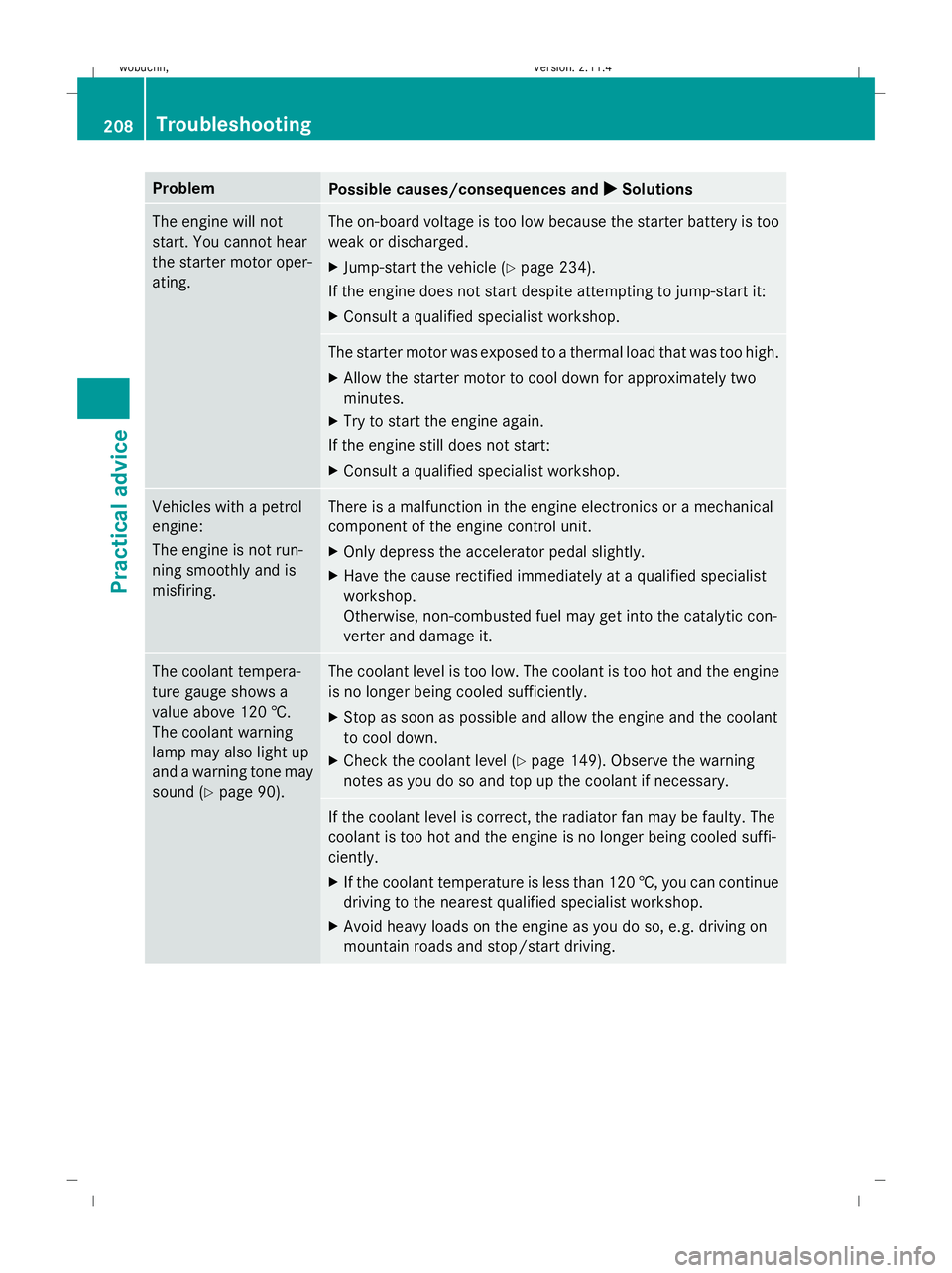
Problem
Possible causes/consequences and
X XSolutions The engine will not
start. You cannot hear
the starter motor oper-
ating. The on-board voltage is too low because the starter battery is too
weak or discharged.
X
Jump-start the vehicle (Y page 234).
If the engine does not start despite attempting to jump-start it:
X Consult a qualified specialist workshop. The starter motor was exposed to a thermal load that was too high.
X
Allow the starter motor to cool down for approximately two
minutes.
X Try to start the engine again.
If the engine still does not start:
X Consult a qualified specialist workshop. Vehicles with a petrol
engine:
The engine is not run-
ning smoothly and is
misfiring. There is a malfunction in the engine electronics or a mechanical
component of the engine control unit.
X
Only depress the accelerator pedal slightly.
X Have the cause rectified immediately at a qualified specialist
workshop.
Otherwise, non-combusted fuel may get into the catalytic con-
verter and damage it. The coolant tempera-
ture gauge shows a
value above 120 †.
The coolant warning
lamp may also light up
and a warning tone may
sound (Y
page 90). The coolant level is too low. The coolant is too hot and the engine
is no longer being cooled sufficiently.
X
Stop as soon as possible and allow the engine and the coolant
to cool down.
X Check the coolant level (Y page 149). Observe the warning
notes as you do so and top up the coolant if necessary. If the coolant level is correct, the radiator fan may be faulty. The
coolant is too hot and the engine is no longer being cooled suffi-
ciently.
X
If the coolant temperature is less than 120 †, you can continue
driving to the nearest qualified specialist workshop.
X Avoid heavy loads on the engine as you do so, e.g. driving on
mountain roads and stop/start driving. 208 TroubleshootingPractical advice
X204_AKB; 1; 5, en-GB
wobuchh,
Version: 2.11.4 2008-10-15T13:20:56+02:00 - Seite 208Dateiname: 6515_0671_02_buchblock.pdf; preflight
Page 212 of 261
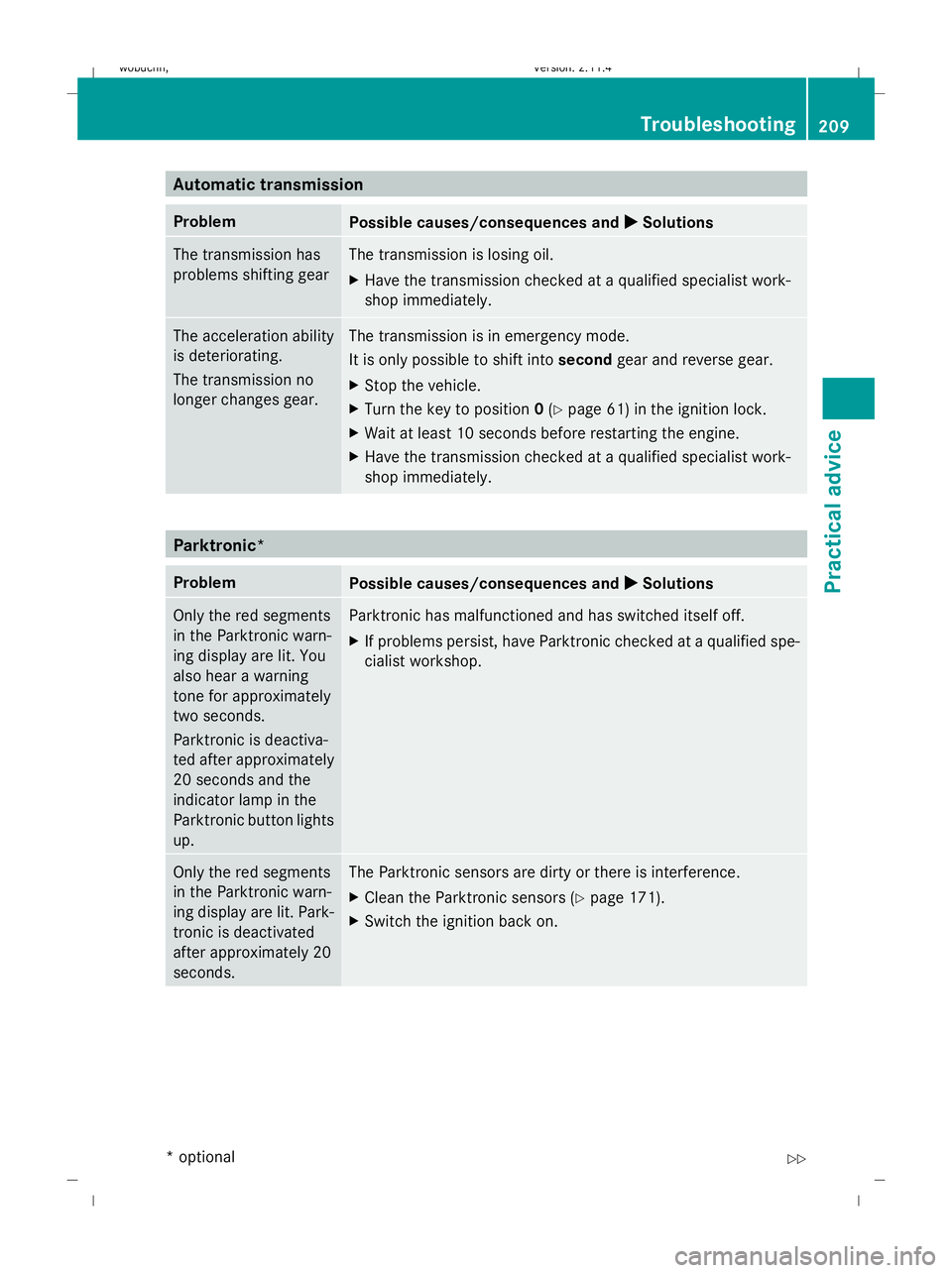
Automatic transmission
Problem
Possible causes/consequences and
X
X Solutions The transmission has
problems shifting gear The transmission is losing oil.
X
Have the transmission checked at a qualified specialist work-
shop immediately. The acceleration ability
is deteriorating.
The transmission no
longer changes gear. The transmission is in emergency mode.
It is only possible to shift into
secondgear and reverse gear.
X Stop the vehicle.
X Turn the key to position 0(Y page 61) in the ignition lock.
X Wait at least 10 seconds before restarting the engine.
X Have the transmission checked at a qualified specialist work-
shop immediately. Parktronic*
Problem
Possible causes/consequences and
X
X Solutions Only the red segments
in the Parktronic warn-
ing display are lit. You
also hear a warning
tone for approximately
two seconds.
Parktronic is deactiva-
ted after approximately
20 seconds and the
indicator lamp in the
Parktronic button lights
up. Parktronic has malfunctioned and has switched itself off.
X
If problems persist, have Parktronic checked at a qualified spe-
cialist workshop. Only the red segments
in the Parktronic warn-
ing display are lit. Park-
tronic is deactivated
after approximately 20
seconds. The Parktronic sensors are dirty or there is interference.
X
Clean the Parktronic sensors (Y page 171).
X Switch the ignition back on. Troubleshooting
209Practical advice
* optional
X204_AKB; 1; 5, en-GB
wobuchh,
Version: 2.11.4 2008-10-15T13:20:56+02:00 - Seite 209 ZDateiname: 6515_0671_02_buchblock.pdf; preflight